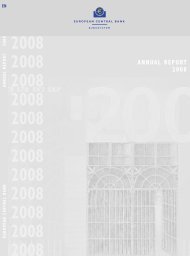Reserve Bank of Australia Annual Report 2011
Reserve Bank of Australia Annual Report 2011
Reserve Bank of Australia Annual Report 2011
You also want an ePaper? Increase the reach of your titles
YUMPU automatically turns print PDFs into web optimized ePapers that Google loves.
Securency<br />
The <strong>Reserve</strong> <strong>Bank</strong> <strong>of</strong> <strong>Australia</strong> has a 50 per cent share in Securency International Pty Ltd, a joint venture with<br />
Innovia Films. Securency International Pty Ltd markets and manufactures the polymer substrate on which<br />
<strong>Australia</strong>’s bank notes are printed. The RBA equity accounts for its investment in Securency International Pty<br />
Ltd in accordance with AASB 131 – Interests in Joint Ventures as the RBA and its partner have joint control <strong>of</strong> the<br />
company. The RBA’s investment in Securency International Pty Ltd is included in Note 7.<br />
In November 2010, the RBA announced it was pursuing a joint sale with Innovia Films <strong>of</strong> its half share in<br />
Securency International Pty Ltd. Macquarie Capital Advisers has been appointed as the adviser to the two<br />
owners. Accordingly, the investment in Securency has been reclassified as held for sale.<br />
(b) Financial instruments<br />
A financial instrument is defined as any contract that gives rise to both a financial asset <strong>of</strong> one entity and<br />
a financial liability or equity instrument <strong>of</strong> another entity. The RBA’s financial instruments are its <strong>Australia</strong>n<br />
dollar securities, foreign government securities, repurchase agreements, deposits with the <strong>Bank</strong> for<br />
International Settlements, foreign currency working accounts, interest rate futures, foreign currency swap<br />
contracts, gold loans, cash and cash equivalents, notes on issue, deposit liabilities and its shareholding in<br />
the <strong>Bank</strong> for International Settlements. The RBA accounts for its financial instruments in accordance with<br />
AASB 139 – Financial Instruments: Recognition and Measurement and reports these instruments under<br />
AASB 7 – Financial Instruments: Disclosures.<br />
The RBA brings its securities transactions and foreign exchange transactions to account on a trade date basis;<br />
that is, it recognises the effects <strong>of</strong> purchases and sales <strong>of</strong> these securities in the Statement <strong>of</strong> Comprehensive<br />
Income and the Balance Sheet on the date these transactions are arranged (not when the transactions are<br />
settled). <strong>Bank</strong> deposits and repurchase agreements are brought to account on settlement date.<br />
Financial Assets<br />
<strong>Australia</strong>n dollar securities<br />
The RBA holds Commonwealth Government securities and securities issued by the central borrowing<br />
authorities <strong>of</strong> state and territory governments. These holdings include fixed coupon, inflation indexed and<br />
discount securities. It also holds under repurchase agreements: bank bills, certificates <strong>of</strong> deposit and debt<br />
securities <strong>of</strong> authorised deposit-taking institutions licensed in <strong>Australia</strong>; <strong>Australia</strong>n dollar denominated<br />
securities issued by foreign governments, foreign government agencies that have an explicit government<br />
guarantee (or equivalent support) and by certain highly-rated supranational organisations; and selected<br />
<strong>Australia</strong>n dollar domestic residential and commercial mortgage-backed securities, asset-backed commercial<br />
paper and corporate securities.<br />
Domestic securities, except those held under buy repurchase agreements, are classified under AASB 139 as<br />
‘at fair value through pr<strong>of</strong>it or loss’, as they are held for purposes <strong>of</strong> conducting monetary policy and may be<br />
sold or lent, typically for short terms, under repurchase agreements. In accordance with this standard, the<br />
securities are valued at market bid prices on balance date; realised and unrealised gains or losses are taken to<br />
pr<strong>of</strong>it. Only realised gains and losses are available for distribution in accordance with the <strong>Reserve</strong> <strong>Bank</strong> Act 1959<br />
(Note 1(f)). Interest earned on the securities is accrued over the term <strong>of</strong> the security and included as revenue in<br />
the Statement <strong>of</strong> Comprehensive Income.<br />
<strong>Annual</strong> report <strong>2011</strong> | notes to the financial statements<br />
77





![KNOW YOUR NEW GIBRALTAR BANKNOTES - [Home] bThe/b](https://img.yumpu.com/50890985/1/184x260/know-your-new-gibraltar-banknotes-home-bthe-b.jpg?quality=85)
![PAPUA NEW GUINEA - [Home] - Polymer Bank Notes of the World](https://img.yumpu.com/49758743/1/190x143/papua-new-guinea-home-polymer-bank-notes-of-the-world.jpg?quality=85)










